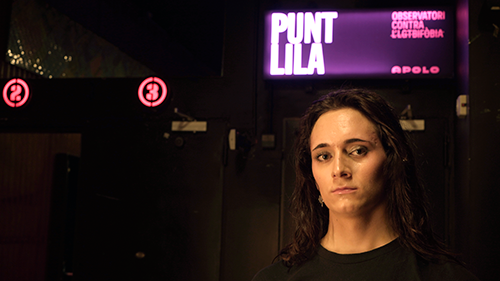The Purple Point at Sala Apolo: Three Years Working Towards Safer Nights

The Purple Point at Sala Apolo: Three Years Working Towards Safer Nights
Since late 2022, the Purple Point has become a key element in the fight against sexual and LGBTI-phobic violence at Sala Apolo. Three years on, we take stock of its evolution, the challenges it faces, and its real impact on nightlife.
Let’s talk with Al Torres Cámara, a social psychologist linked to the Observatory against LGBTI-phobia since May 2024 and currently the coordinator of the Purple Point at Sala Apolo, where she began in March 2025
How has the Purple Point evolved since its launch?
The Purple Point started at the end of 2022 and, since then, four different professionals have worked there. Its core operation remains the same, particularly regarding reporting and internal management. The biggest change, however, comes from each professional’s perspective, always within a shared framework based on consent, the prevention of sexual and LGBTI-phobic assaults, and the No Callem protocol, in coordination with the Observatory Against LGBTI-phobia.
What changes have you implemented over the years to adapt to the audience and social context?
The evolution of the Purple Point also depends on the audience and context. For example, at parties like Milkshake, with a younger crowd and large groups, we use a trivia-style quiz on sexuality and history to spark conversations. In contrast, at events like Nitsa, it’s more useful to bring materials about exhibitions, talks or cultural activities to start dialogues and build connections with attendees.
Why is it essential to maintain a permanent Purple Point in nightlife venues like Sala Apolo?
Because specific knowledge is needed to act in the face of an assault. It’s not just about reacting quickly, but acting with a perspective aimed at social transformation. Nightlife is often a space lacking clear codes around boundaries, especially due to the presence of alcohol and drugs, which has been used as an excuse to justify unacceptable behaviour. The Purple Point helps establish these codes and make the night a safer space.
What indicators confirm that the Purple Point has a real impact on reducing violence?
Internally, we keep a record of incidents and produce reports sent to Sala Apolo, which allows us to observe the quantitative evolution of assaults. Even so, our main task is to intervene when assaults occur and offer the affected person information, psychological support and resources if they wish. We also carry out preventive work when we detect behaviours that could escalate, and our presence has a deterrent effect.
According to the data collected, what are the most common situations detected at the venue?
Since I joined, the most frequent cases are sexual or sexist assaults where a man invades the personal space of a woman or group of women and persistently tries to flirt in an annoying way, until the situation is reported and we intervene.
How have these situations been addressed?
Always following the No Callem Protocol, we respect the wishes of the affected person. When possible, we explain to the aggressor the reason for the intervention. Often, the requested measure is the expulsion of the person who committed the assault.
How does the Purple Point coordinate with protocols like “No Callem” and with the Observatory Against Homophobia?
We act in line with the principles of both entities and refer relevant cases. We also maintain fluid communication in ambiguous, complex or urgent situations.
What challenges do you face in strengthening this initiative in the coming years?
Given the rise in social polarisation and the legitimisation of sexual and LGBTI-phobic violence in some media discourses, continuing with educational work is essential. We must foster dialogue and establish codes that respect everyone’s integrity, so that Sala Apolo and any nightlife space become places where no one feels threatened for existing within dissidence or coexisting with it.
Do you think this model can serve as an example for other nightlife spaces in Catalonia?
There is no single model; each venue has specific needs. In other European cities, for example, Awareness Teams take a more preventive approach. What is clear is that trained staff are needed to deal with these situations. But our work alone cannot cover the complexity of the problem: if nightlife spaces mostly hire male DJs, if they don’t give space to women, LGBTI dissidents or racialised people, or if staff display discriminatory attitudes, we will never be talking about safe spaces. We are just a small part of a set of measures that must be taken at both corporate and social levels.

![Landscapes transforms La [3] into a living, ever-changing space with its work: PRISM Landscapes transforms La [3] into a living, ever-changing space with its work: PRISM](/uploads/media/default/0001/11/thumb_10484_default_card.png)